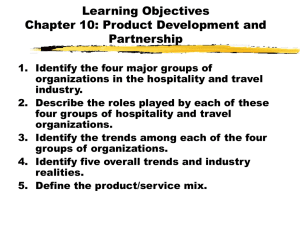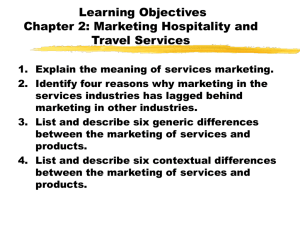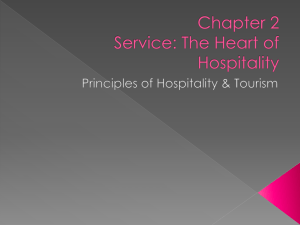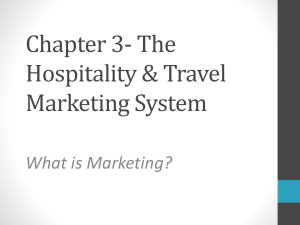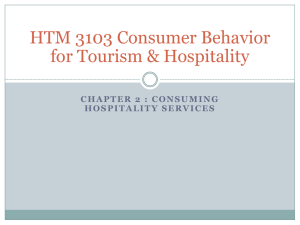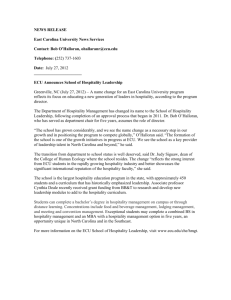Chapter Two
advertisement
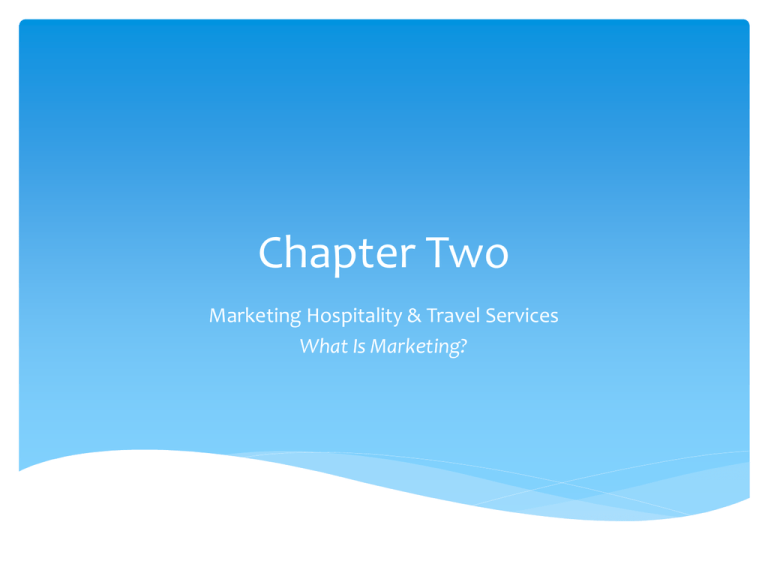
Chapter Two Marketing Hospitality & Travel Services What Is Marketing? Service Industries Organizations primarily involved in the provision of personal services. Service Industries Hospitality and Travel industry Banking Legal Accounting Management consulting services Insurance Health Care Laundry & dry cleaning Education Entertainment Why services marketing lag behind Marketing terms & principles were defined with the manufacturing industry in mind. Government regulation, monopoly: no need for marketing. Hospitality & travel industry is dominated by small business. Small businesses cannot afford full-time marketing managers with limited budgets. Management lacks knowledge of marketing concepts Why is services marketing different The marketing of hospitality and travel services has several unique characteristics. Some are shared with all service organizations (generic). Others exist because of the ways in which service organizations are managed and regulated (contextual). Generic Differences Contextual Differences Hospitality and Travel Differences -Intangibility -Narrow definition of marketing -Shorter exposure to services -Production Methods -Lack of appreciation of marketing skills -More emotional buying appeals -Perishability -Different organizational structure -Greater importance on managing experience clues -Distribution channels -Lack of data on competitive performance -Greater emphasis on stature & imagery -Cost determination -Impact of Gov. regulation and deregulation -More variety & types of distribution channels -Relationships of service providers -Constraints & opportunities for nonprofit marketers -More dependence on complementary organizations -More emphasis on off-peak promotions. Different Marketing Approaches Needed for Hospitality & Travel Marketing in the hospitality and travel industry is becoming more sophisticated and the industry is steadily becoming less regulated. Generic and specific hospitality and travel service differences will remain forever. Because of these ever-present differences, unique marketing approaches are required in our industry. Five approaches Use of more than 4 Ps (People, packaging & programming, partnership) Greater significance of word-of-mouth information More use of emotional appeals in promotions Greater difficulties with new-concept testing Increased importance of relationships with complementary organizations. (Suppliers, Carriers, Travel Trade Intermediaries, and Destination Marketing Organizations) Suppliers, carriers, the travel trade, and destination marketing organizations Suppliers: organizations that operate facilities, attractions and events, ground transportation, and other support services in or between travel destinations. facilities: lodging, food and beverage attractions and events: natural resource, climatic, cultural, historical, ethnic, and accessible Ground transportation: car rental, taxi and limousine, bus, and other related services support industries: retail shopping, tour guiding, and recreation Continued Carriers: companies providing transportation to the destination--airlines, railway, bus, ship and ferry companies Travel trade: intermediaries that suppliers and carriers use to get their services to customers--retail travel agents and tour wholesalers Destination marketing organizations: market their cities , areas, regions, countries, states or provinces and countries to travel trade intermediaries and individual and group travelers Questions? Should services be marketed exactly the same as manufactured products and packaged goods? Why or why not? What are the four additional 4Ps suggested by the author of the textbook? What are three key relationships among organizations and individuals in the hospitality and travel industry?

